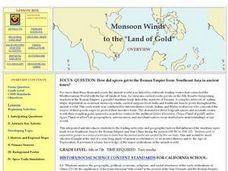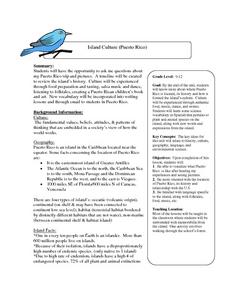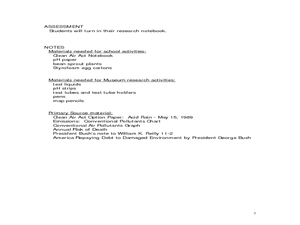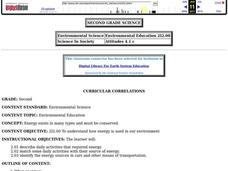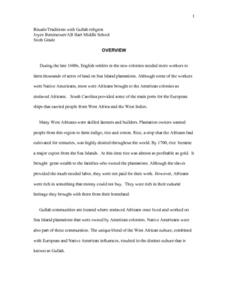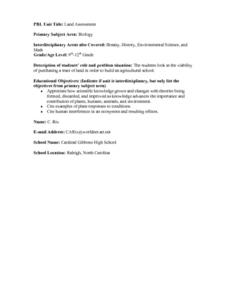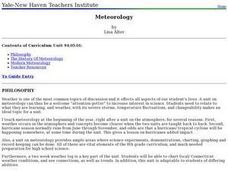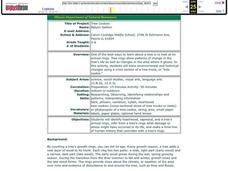Curated OER
Making Your Local Ethical Shopping Guide
Learners write a research action plan on how to buy products that are environmentally friendly even in tough world conditions. In this ethical business lesson plan, students learn that the economy, food prices, natural disasters, and...
Curated OER
Turbulent Times of the Sixties
Students explore 1960's America. In this American history lesson, students read about and research 1960's political and entertainment figures, social activism, the Civil Rights Movement, and environmentalism as they complete writing and...
Curated OER
Monsoon Winds to the "Land of Gold"
Students recognize environmental factors that influenced maritime trade routes and the establishment of major trading centers in classical times. They evaluate perceptions of the ancient world through ancient maps and primary source...
Curated OER
Island Culture: Puerto Rico
Students explore the culture of Puerto Rico. They create maps of Puerto Rico and the Caribbean. They work in small groups to research a decade in history and add drawings and pictures to a timeline of their decade. They practice...
Curated OER
The Progressives
In this Progressive Era worksheet, young scholars review a chapter as they read 10 descriptions identifying who or what is speaking, respond to 4 short answer questions, and explain a historical theme regarding this time period in United...
Curated OER
CLEAN AIR ACT (1990)
Students investigate the effects of acid rain by conducting an experiment with bean sprouts and graph the results. In this Environmental Policy lesson, students visit a museum to identify examples of foreign and domestic policy on...
Curated OER
Mother Jones
In this online interactive history worksheet, students respond to 8 essay and short answer questions about Mother Jones and her contributions to the Progressive Movement.
Curated OER
The First Earth Day
In this Earth Day worksheet, students read about the history of the first Earth Day and answer short answer questions about it. Students complete 8 questions total.
Curated OER
Fossil Fuels (III), The Geology of Coal: Interpreting Geologic History
Young scholars hypothesize about why various samples of coal have different characteristics. Pupils use information that they found during Internet searches to ascertain the validity of their hypotheses and verify the "story" of coal. ...
Curated OER
Environmental Education
Second graders discuss the different forms of energy and their sources. They work with a partner to answer a variety of questions revolving around energy. They develop a scientific attitude about renewable energy.
Curated OER
Parallel Timelines
Twelfth graders research the history of how a particular environmental issue moves through the Conservation Movement. They create timelines that show the progression of public sentiment and the legislation about the issue.
Curated OER
Rituals/traditions with Gullah religion
Sixth graders discuss some of the earliest people who lived in each region in order to comprehend how humans interacted with the environmental conditions at that time. They make connections to present-day regions including...
Curated OER
Environmentalism: Then and Now
Tenth graders examine the history of the conservation movement and how it relates to contemporary issues. In this Environmental Science activity, 10th graders research the roots of the environmental and conservation movement and...
Centers for Disease Control and Prevention
Diabetes in the Family: A Case Study
Students examine a case study of a woman with a family history of type 2 diabetes and create a "family health portrait" that assesses her risk of developing diabetes. They use the family health portrait to record the woman's family...
Curated OER
Land Assessment
Students work in small groups on a problem based learning activity. Students are presented with a problem of buying land to use for educational purposes only and must determine if it is feasible to buy it based on soil analysis and plant...
Texas Education Agency (TEA)
Byzantine Architecture
View Byzantine architecture from the comfort of your classroom. A PowerPoint presentation introduces important vocabulary terms and examples of Byzantine architecture in the ninth lesson plan of the 11-part series. A Jeopardy game...
Curated OER
Smogasbord
When your environmental or earth science class is studying air pollution, you will want to take the time to go over this resource. Pupils peruse the history of air pollution regulations and examine outstanding diagrams of what...
National Energy Education Development Project
Exploring Hydropower
In 2006, about 20 percent of the world's electricity was generated from hydroelectric power. In the presentation, scholars review the water cycle and gravitational energy to begin to understand how humans harness the power of water. They...
Curated OER
Ghostbusting in the Chesapeake
Ghost pots, fishing gear lost during crabbing expeditions, continue to trap crabs that are never collected. Increase your budding ecologists' awareness of human impact on the environment as well as conservation efforts using this...
Curated OER
Soil Porosity, Moisture Content, pH, and Density
This lab activity does not have to be done with AP environmental scientists. It can also be done with middle to high school earth scientists. The procedures aren't complex. Learners determine the density of dry and wet sand in order to...
Curated OER
Revolutionary Money
Examine paper money from the American revolution! Historians study the paper bills and discuss the history of money. How has money changed over the times? Activities are included.
Curated OER
Feeding in the Flow
The National Oceanic and Atmospheric Administration (NOAA) has developed a tremendous library of ocean-themed lessons that can be used in a variety of science settings. "Feeding in the Flow" is one of those activities; Its focus is on...
Curated OER
Meteorology
Students research and produce an oral history that reflects the importance of meterologists in the lives of people in their community.
Curated OER
Tree Cookies
Young scholars identify heartwood, sapwood, and a tree's annual rings, infer from a tree's rings what damage or stress might have occurred in its life, and make a time-line of human history that coincides with a tree's rings.




